Inside eight of the best fashion designers' homes
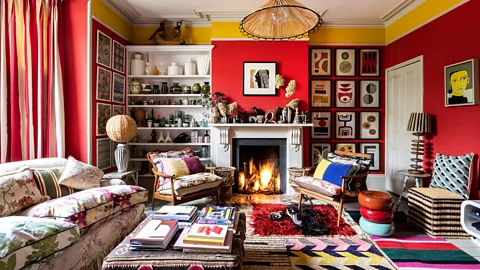 Robyn Lea
Robyn LeaEach of these remarkable interiors reflects its creative owner's unique vision – from a British bohemian-lady-of-the-manor style to a 14th-Century Florentine palazzo with added neon zing.
When fashion people pour their creativity into their homes, the results can be tactile interiors that visitors may wish they could wear. "You walk into those spaces and it just blows your mind," Australian photographer, author and director Robyn Lea tells the BBC. Lea's latest photo book, This Creative Life – Fashion Designers at Home, published this month, features a catwalk of 18 homes, all owned by leading fashion creatives.
The book derives from Lea's curiosity about the drive to design. "I'm fascinated with the genesis of the creative spirit, and where that comes from – and why someone needs to create," she says. It's a work that explores, she says, "the synergy between the fashion design and the interiors, and how they really are one visual language". These fashion designers don't just wear their designs, they inhabit them. "They don't see any delineation," Lea adds. For them, the clothes they wear and the homes they live in are "one and the same thing". Here are eight interiors from the book.
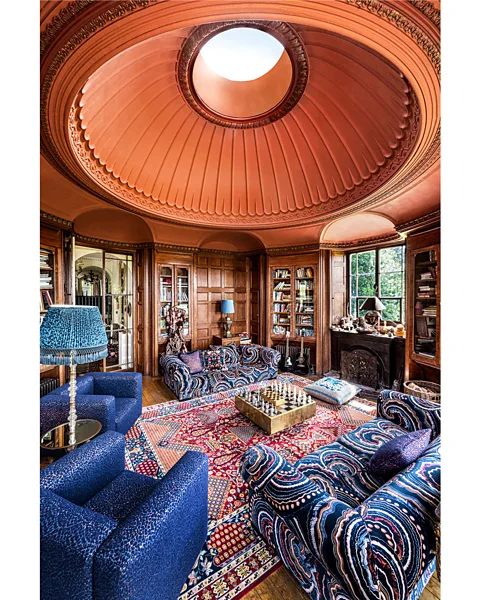 Robyn Lea
Robyn LeaAlice Temperley
The entrance to British designer Alice Temperley's Regency manor house in Somerset, UK, features Doric columns and a giant disco ball. It's an aesthetic described in the book as "bohemian-lady-of-the-manor meets rock chick". Inside, the experience is like swishing through rails of her glittery, richly-embroidered dresses. There are gold accents and sparkles all around; bold, patterned textiles; and dresses, Lea writes, that "hang like paintings". It's a home that's "just laden with fabric and colour… It's a really wild ride in there". In the library, a play of complementary colours sees a marmalade-coloured domed ceiling loom over royal blue sofas and armchairs. The swirls and animal prints of the seat covers come from a collaboration with textile-and-wall-covering designer Romo, where Temperley London's patterns and prints were reimagined as homeware, embodying the natural harmony between fashion and interior design.
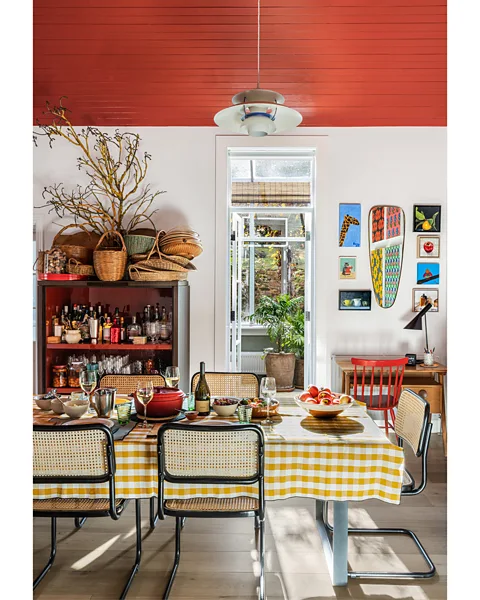 Robyn Lea
Robyn LeaTamasine Dale
Homes and hats come together in the Melbourne and Castlemaine properties of Australian milliner Tamasine Dale. "She's obsessed with the handmade," Lea explains. As a child she made things and sold them at a local craft market. Her homes retell this story of compulsive industry and creativity. Natural, straw-coloured materials that recall the weave of her hats feature heavily. In her kitchen, for example, we see clusters of hand-woven baskets and vintage Marcel Breuer chairs made of woven cane. The milliner's own sculptures, ceramics and pottery are dotted throughout her house. "Again, it's that attraction to the three-dimensional form. You see her interest in the surface texture, but also the melding of that form into a shape that expresses beauty to her," says Lea. "So whether that's a bowl or a hat, it's coming from the same place."
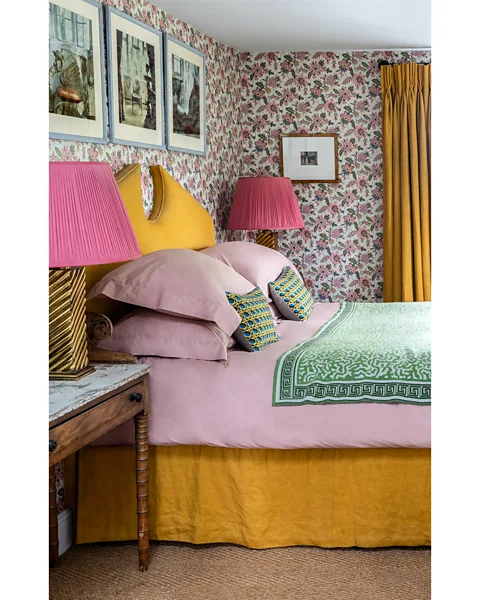 Robyn Lea
Robyn LeaLuke Edward Hall
Creative polymath Luke Edward Hall, who founded his fashion label Chateau Orlando in 2022, shares a stone farmhouse in Gloucestershire with his husband, interior and furniture designer Duncan Campbell, and their two whippets. His designs and collaborations draw on his love of the eccentric British upper classes – striped waistcoats, patterned tank tops, corduroy blazers and velvet slippers – and these inspire and are inspired by his bucolic Cotswolds home. A dresser full of vintage crockery in the dining room, an antique Staffordshire dog watching over the hearth and pink floral wallpaper in the bedroom all speak to the nostalgic vision of England that permeates his designs. He says in the book: "The boundaries between my work and private life are very blurry, and all the aesthetics roll into one, which is just how I like it."
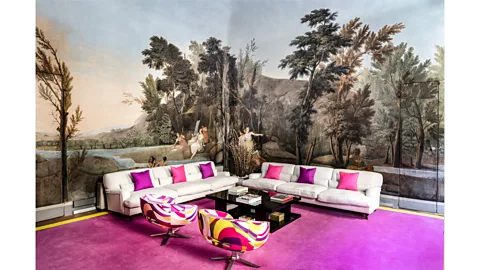 Robyn Lea
Robyn LeaLaudomia Pucci
The legendary Italian designer the Marquis Emilio Pucci (1914-1992), a renaissance man living in a Renaissance palace, did not confine his creative vision to fashion, but launched perfume and homeware – and even dabbled in car design. He was, says Lea, "one of the first full lifestyle brand designers". When his daughter Laudomia took over the reins, she went a step further by introducing the label's flamboyant geometric designs – in Emilio's beloved fuchsia pink and turquoise – into Palazzo Pucci in Florence, the family's ancestral home. "She really took the brand, and brought and guided it into the new century," says Lea. "Not many people would be brave enough to touch a 14th-Century palazzo and bring so much vibrancy and colour into it."
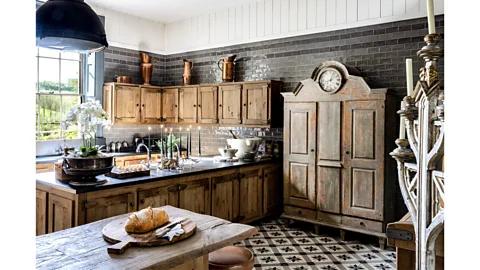 Robyn Lea
Robyn LeaJade Holland Cooper
The daughter of an arable farmer and a fashion designer, it's apt that Jade Holland Cooper should design clothing inspired by the British countryside − think tweed field jackets, quilted gilets and equestrian wear. This love of the outdoors is also conveyed in the family home near Cheltenham that she shares with her husband Julian Dunkerton, the co-founder of clothing brand Superdry, and their two children. "Whether I'm designing a room or the garden or an item of clothing, it's all the same," says Holland Cooper in the book. Set in 160 hectares, the neoclassical Bath stone house is full of natural wood, brown leather and greenery, and features a mudroom with rows of Holland Cooper's sherpa-lined Wellington boots. The opened-up ceilings and vistas also draw the outdoors in. "She lives and breathes her brand," says Lea.
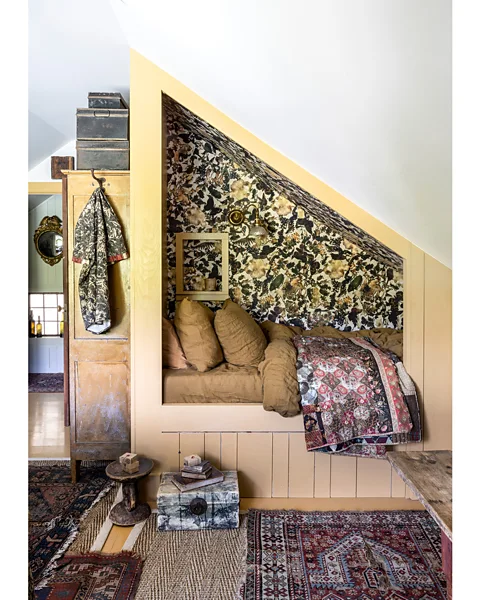 Robyn Lea
Robyn LeaGary Graham
"I felt like time had stopped when I stepped inside their place," Lea says of the property that Gary Graham shares with his partner, artist, collector and interior designer Sean Scherer. Graham is renowned for his one-off designs that give antique materials a new life, so it's fitting that he should inhabit a 19th-Century building that has also had several iterations – bank, post office and department store – and that is now filled with repurposed vintage furnishings and fabrics. The sleeping nook built into a wall is a case in point. "It just looks so cosy, don't you think? I want to get in there," says Lea. "He developed that wallpaper from a vintage ginger jar, and he's also used that same motif for some of his fashion designs. It's all so connected."
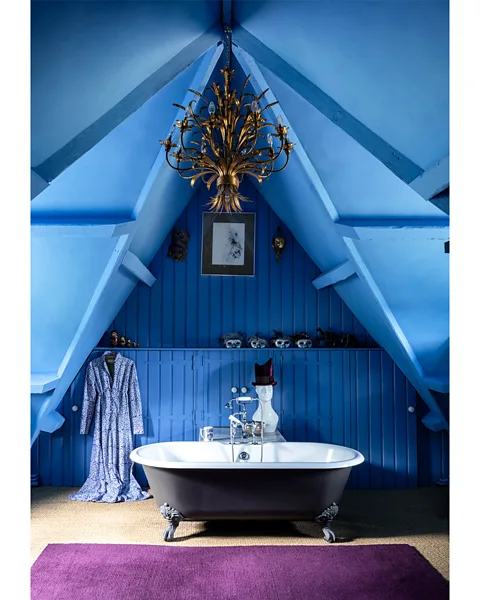 Robyn Lea
Robyn LeaSelina Blow
"I'm not an interior designer," insists Selina Blow in This Creative Life, yet the saturated colours of her tailored velvets, silks and linens reappear in the colour-blocked décor of her 200-year-old Gloucestershire farmhouse. Blow attributes this love of colour to her mother, who missed the bright colours of her Sri Lankan homeland, and so brought them into the family home. "I think that's always been my thing, Gothic with strong colours," says Blow. Her dramatic blue bathroom, for example, features a black claw-foot bath beside a watchful row of masquerade masks and a bust wearing one of her beloved Philip Treacy hats. Interior designer or not, Blow's bold aesthetic pervades. "It does take a lot of courage and confidence to paint a whole room that really vivid blue," says Lea. "And then you see that in a jacket of the same colour that she wears."
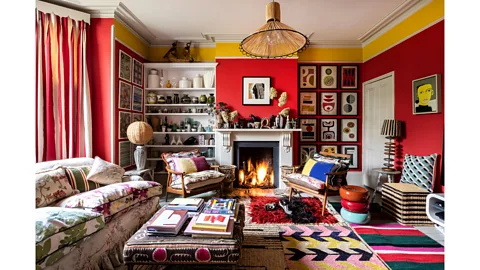 Robyn Lea
Robyn LeaLucinda Chambers
The maximalist London home of Lucinda Chambers, co-founder of fashion label Colville and former fashion director of Vogue, is a far cry from the squat she once called home in the '80s, but still contains the bohemian spirit of those early years, with mismatched fabrics in the living room and a vibrant colour scheme. Colville's travel-inspired geometric patterns are all around and, as with her clothing, comfort is key. Building an interior design, says Chambers, is a lot like dressing. "Choose a sofa and table before adding or subtracting other elements," she advises, "like adding earrings, beads or a bag". For Chambers, "no boundary" separates the two creative forms. "You decorate your body like you decorate the house you live in," she says.
This Creative Life – Fashion Designers at Home by Robyn Lea is published by Thames & Hudson.
--
If you liked this story, sign up for The Essential List newsletter – a handpicked selection of features, videos and can't-miss news, delivered to your inbox twice a week.
